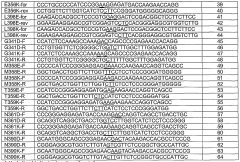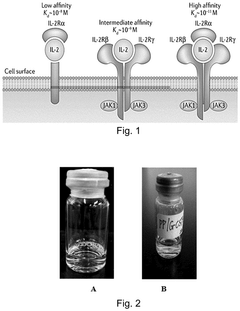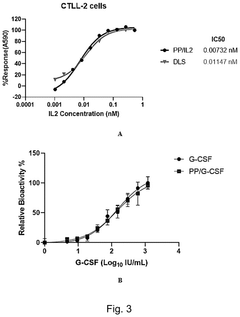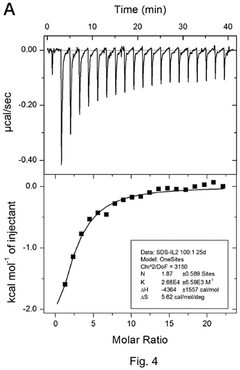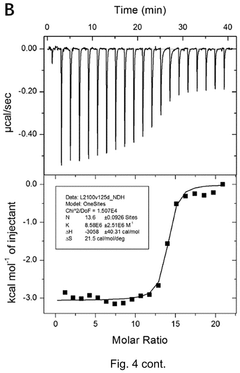Effect of Heptane on Protein Structure Stability in Drug Formulations
JUL 25, 20259 MIN READ
Generate Your Research Report Instantly with AI Agent
Patsnap Eureka helps you evaluate technical feasibility & market potential.
Heptane-Protein Interaction Background
Heptane, a straight-chain alkane hydrocarbon, has been increasingly utilized in various pharmaceutical applications, particularly in drug formulations. The interaction between heptane and proteins has become a subject of significant interest in the field of drug development and delivery. This growing attention stems from the potential impact of heptane on protein structure stability, which is crucial for maintaining the efficacy and safety of biopharmaceutical products.
The study of heptane-protein interactions dates back to the early 1990s when researchers began investigating the effects of organic solvents on protein stability. Initially, the focus was primarily on shorter-chain alkanes, but as the pharmaceutical industry expanded its repertoire of solvents, heptane emerged as a compound of interest due to its unique properties and potential applications in drug formulations.
Heptane's role in pharmaceutical processes is multifaceted. It is commonly used as a solvent in various stages of drug production, including extraction, purification, and formulation. Its low polarity and ability to dissolve non-polar substances make it particularly useful in lipid-based drug delivery systems. However, the introduction of heptane into protein-containing formulations raised questions about its potential effects on protein structure and function.
The interaction between heptane and proteins is complex and depends on various factors, including the protein's structure, the concentration of heptane, and environmental conditions such as temperature and pH. Generally, heptane, being a non-polar solvent, can disrupt the hydrophobic interactions within proteins, potentially leading to conformational changes or even denaturation.
Early studies focused on the macroscopic effects of heptane on protein solutions, such as changes in solubility and aggregation behavior. As analytical techniques advanced, researchers began to probe the molecular-level interactions between heptane and specific protein domains. Spectroscopic methods, including circular dichroism and fluorescence spectroscopy, have been instrumental in elucidating the structural changes induced by heptane exposure.
The pharmaceutical industry's interest in heptane-protein interactions has been driven by the need to develop stable and effective drug formulations, especially for proteins and peptides. Understanding these interactions is crucial for predicting and mitigating potential stability issues in drug products. This knowledge has led to the development of novel formulation strategies that aim to protect proteins from the potentially destabilizing effects of heptane while still leveraging its beneficial properties as a solvent.
Recent years have seen an increased focus on computational approaches to study heptane-protein interactions. Molecular dynamics simulations and other in silico methods have provided valuable insights into the molecular mechanisms underlying these interactions, complementing experimental studies and guiding formulation design.
The study of heptane-protein interactions dates back to the early 1990s when researchers began investigating the effects of organic solvents on protein stability. Initially, the focus was primarily on shorter-chain alkanes, but as the pharmaceutical industry expanded its repertoire of solvents, heptane emerged as a compound of interest due to its unique properties and potential applications in drug formulations.
Heptane's role in pharmaceutical processes is multifaceted. It is commonly used as a solvent in various stages of drug production, including extraction, purification, and formulation. Its low polarity and ability to dissolve non-polar substances make it particularly useful in lipid-based drug delivery systems. However, the introduction of heptane into protein-containing formulations raised questions about its potential effects on protein structure and function.
The interaction between heptane and proteins is complex and depends on various factors, including the protein's structure, the concentration of heptane, and environmental conditions such as temperature and pH. Generally, heptane, being a non-polar solvent, can disrupt the hydrophobic interactions within proteins, potentially leading to conformational changes or even denaturation.
Early studies focused on the macroscopic effects of heptane on protein solutions, such as changes in solubility and aggregation behavior. As analytical techniques advanced, researchers began to probe the molecular-level interactions between heptane and specific protein domains. Spectroscopic methods, including circular dichroism and fluorescence spectroscopy, have been instrumental in elucidating the structural changes induced by heptane exposure.
The pharmaceutical industry's interest in heptane-protein interactions has been driven by the need to develop stable and effective drug formulations, especially for proteins and peptides. Understanding these interactions is crucial for predicting and mitigating potential stability issues in drug products. This knowledge has led to the development of novel formulation strategies that aim to protect proteins from the potentially destabilizing effects of heptane while still leveraging its beneficial properties as a solvent.
Recent years have seen an increased focus on computational approaches to study heptane-protein interactions. Molecular dynamics simulations and other in silico methods have provided valuable insights into the molecular mechanisms underlying these interactions, complementing experimental studies and guiding formulation design.
Pharmaceutical Market Analysis
The pharmaceutical market is experiencing significant growth, driven by increasing global healthcare needs and advancements in drug formulation technologies. The global pharmaceutical market size was valued at $1.4 trillion in 2021 and is projected to reach $1.9 trillion by 2027, growing at a CAGR of 5.5% during the forecast period. This growth is particularly evident in the area of protein-based drugs, which have gained substantial traction due to their high specificity and efficacy in treating various diseases.
The demand for protein-based drugs has led to increased focus on formulation stability, with particular attention to the effects of excipients and solvents on protein structure. Heptane, a hydrocarbon solvent, has emerged as a subject of interest in pharmaceutical formulations due to its potential impact on protein stability. The global market for pharmaceutical excipients, including solvents like heptane, was valued at $7.9 billion in 2020 and is expected to reach $10.6 billion by 2026, growing at a CAGR of 5.8%.
In the context of drug formulations, the stability of protein structures is crucial for maintaining therapeutic efficacy and safety. The use of heptane in pharmaceutical processes has raised questions about its effects on protein stability, prompting research and development efforts to optimize formulation strategies. This has created a niche market for analytical tools and services focused on protein structure analysis, estimated to be worth $1.3 billion in 2021 and projected to grow at a CAGR of 6.7% through 2026.
The increasing complexity of biopharmaceutical formulations has also driven demand for advanced characterization techniques and stability testing services. The global pharmaceutical analytical testing outsourcing market, which includes protein stability studies, was valued at $6.1 billion in 2020 and is expected to reach $11.4 billion by 2028, growing at a CAGR of 8.3%.
Geographically, North America dominates the pharmaceutical market, accounting for approximately 45% of global pharmaceutical sales. However, emerging markets in Asia-Pacific, particularly China and India, are experiencing rapid growth in both drug manufacturing and research activities related to protein formulation stability. These regions are expected to play an increasingly important role in addressing challenges associated with protein stability in the presence of solvents like heptane.
The market analysis reveals a growing need for innovative solutions to enhance protein stability in drug formulations. This presents opportunities for companies specializing in excipient development, analytical services, and formulation technologies. As the pharmaceutical industry continues to evolve, the demand for research and development in this area is expected to increase, driving further market growth and technological advancements in protein-based drug formulations.
The demand for protein-based drugs has led to increased focus on formulation stability, with particular attention to the effects of excipients and solvents on protein structure. Heptane, a hydrocarbon solvent, has emerged as a subject of interest in pharmaceutical formulations due to its potential impact on protein stability. The global market for pharmaceutical excipients, including solvents like heptane, was valued at $7.9 billion in 2020 and is expected to reach $10.6 billion by 2026, growing at a CAGR of 5.8%.
In the context of drug formulations, the stability of protein structures is crucial for maintaining therapeutic efficacy and safety. The use of heptane in pharmaceutical processes has raised questions about its effects on protein stability, prompting research and development efforts to optimize formulation strategies. This has created a niche market for analytical tools and services focused on protein structure analysis, estimated to be worth $1.3 billion in 2021 and projected to grow at a CAGR of 6.7% through 2026.
The increasing complexity of biopharmaceutical formulations has also driven demand for advanced characterization techniques and stability testing services. The global pharmaceutical analytical testing outsourcing market, which includes protein stability studies, was valued at $6.1 billion in 2020 and is expected to reach $11.4 billion by 2028, growing at a CAGR of 8.3%.
Geographically, North America dominates the pharmaceutical market, accounting for approximately 45% of global pharmaceutical sales. However, emerging markets in Asia-Pacific, particularly China and India, are experiencing rapid growth in both drug manufacturing and research activities related to protein formulation stability. These regions are expected to play an increasingly important role in addressing challenges associated with protein stability in the presence of solvents like heptane.
The market analysis reveals a growing need for innovative solutions to enhance protein stability in drug formulations. This presents opportunities for companies specializing in excipient development, analytical services, and formulation technologies. As the pharmaceutical industry continues to evolve, the demand for research and development in this area is expected to increase, driving further market growth and technological advancements in protein-based drug formulations.
Current Challenges in Protein Stability
Protein stability remains a critical challenge in drug formulations, particularly when considering the effects of organic solvents like heptane. The complexity of protein structures and their sensitivity to environmental factors pose significant hurdles in maintaining their stability during formulation, storage, and administration.
One of the primary challenges is the potential for protein denaturation or unfolding in the presence of heptane. This non-polar solvent can disrupt the delicate balance of hydrophobic and hydrophilic interactions that maintain a protein's native structure. As a result, proteins may lose their tertiary structure, leading to aggregation or loss of biological activity, which is detrimental to drug efficacy and safety.
Another significant issue is the impact of heptane on protein solubility. The introduction of this organic solvent can alter the solubility characteristics of proteins, potentially leading to precipitation or the formation of insoluble aggregates. This not only affects the bioavailability of the drug but also raises concerns about the formation of immunogenic particles that could trigger adverse immune responses in patients.
The interaction between heptane and protein excipients presents an additional layer of complexity. Excipients, which are crucial for maintaining protein stability and enhancing drug delivery, may behave differently in the presence of heptane. This can lead to unexpected changes in formulation properties, such as viscosity, pH, or ionic strength, further compromising protein stability.
Oxidative stress is another concern when using heptane in protein formulations. The solvent may introduce or exacerbate oxidative conditions, leading to chemical modifications of amino acid residues, particularly those containing sulfur or aromatic groups. These modifications can result in protein degradation, loss of function, or the formation of potentially toxic byproducts.
The challenge of maintaining long-term stability in heptane-containing formulations is particularly daunting. Proteins may exhibit different degradation kinetics in the presence of this organic solvent, necessitating the development of new stability prediction models and accelerated stability testing protocols. This is crucial for ensuring the shelf life and efficacy of protein-based drugs throughout their intended storage period.
Furthermore, the potential for heptane to affect the conformational dynamics of proteins poses a significant challenge. Even subtle changes in protein flexibility or local unfolding events can impact the drug's pharmacokinetics, pharmacodynamics, and overall therapeutic efficacy. Understanding and controlling these dynamic processes in the presence of heptane is essential for developing robust formulations.
Lastly, the regulatory landscape surrounding the use of organic solvents like heptane in protein formulations adds another layer of complexity. Ensuring compliance with safety guidelines while maintaining protein stability requires a delicate balance and may necessitate innovative formulation strategies or alternative approaches to drug delivery.
One of the primary challenges is the potential for protein denaturation or unfolding in the presence of heptane. This non-polar solvent can disrupt the delicate balance of hydrophobic and hydrophilic interactions that maintain a protein's native structure. As a result, proteins may lose their tertiary structure, leading to aggregation or loss of biological activity, which is detrimental to drug efficacy and safety.
Another significant issue is the impact of heptane on protein solubility. The introduction of this organic solvent can alter the solubility characteristics of proteins, potentially leading to precipitation or the formation of insoluble aggregates. This not only affects the bioavailability of the drug but also raises concerns about the formation of immunogenic particles that could trigger adverse immune responses in patients.
The interaction between heptane and protein excipients presents an additional layer of complexity. Excipients, which are crucial for maintaining protein stability and enhancing drug delivery, may behave differently in the presence of heptane. This can lead to unexpected changes in formulation properties, such as viscosity, pH, or ionic strength, further compromising protein stability.
Oxidative stress is another concern when using heptane in protein formulations. The solvent may introduce or exacerbate oxidative conditions, leading to chemical modifications of amino acid residues, particularly those containing sulfur or aromatic groups. These modifications can result in protein degradation, loss of function, or the formation of potentially toxic byproducts.
The challenge of maintaining long-term stability in heptane-containing formulations is particularly daunting. Proteins may exhibit different degradation kinetics in the presence of this organic solvent, necessitating the development of new stability prediction models and accelerated stability testing protocols. This is crucial for ensuring the shelf life and efficacy of protein-based drugs throughout their intended storage period.
Furthermore, the potential for heptane to affect the conformational dynamics of proteins poses a significant challenge. Even subtle changes in protein flexibility or local unfolding events can impact the drug's pharmacokinetics, pharmacodynamics, and overall therapeutic efficacy. Understanding and controlling these dynamic processes in the presence of heptane is essential for developing robust formulations.
Lastly, the regulatory landscape surrounding the use of organic solvents like heptane in protein formulations adds another layer of complexity. Ensuring compliance with safety guidelines while maintaining protein stability requires a delicate balance and may necessitate innovative formulation strategies or alternative approaches to drug delivery.
Heptane-Based Formulation Strategies
01 Protein structure prediction and analysis
Methods and systems for predicting and analyzing protein structures, including computational approaches to determine protein folding, stability, and interactions. These techniques help in understanding protein function and designing stable protein variants.- Protein structure prediction and analysis: Methods and systems for predicting and analyzing protein structures, including computational approaches to determine protein folding, stability, and interactions. These techniques help in understanding protein function and designing stable protein variants.
- Stabilization of protein structures through mutations: Techniques for enhancing protein stability through targeted mutations, including site-directed mutagenesis and rational design approaches. These methods aim to improve the thermal and chemical stability of proteins for various applications.
- Formulation strategies for protein stability: Development of formulation strategies to maintain protein structure stability, including the use of excipients, buffers, and other additives. These approaches are crucial for preserving protein function during storage and administration.
- Protein engineering for improved stability: Methods for engineering proteins to enhance their structural stability, including directed evolution, consensus design, and computational protein design. These techniques aim to create proteins with improved thermodynamic and kinetic stability.
- Analytical methods for assessing protein stability: Development and application of analytical techniques to evaluate protein structure stability, including spectroscopic methods, calorimetry, and high-throughput screening assays. These methods enable the characterization of protein folding, unfolding, and aggregation behaviors.
02 Stabilizing mutations in protein engineering
Techniques for introducing mutations into protein sequences to enhance structural stability. This includes identifying key residues, designing stabilizing mutations, and evaluating their impact on protein folding and function.Expand Specific Solutions03 Formulation strategies for protein stability
Development of formulation strategies to improve protein stability in various environments. This includes the use of excipients, pH adjustments, and other additives to maintain protein structure and function during storage and application.Expand Specific Solutions04 Biophysical methods for assessing protein stability
Application of biophysical techniques to evaluate protein structure stability. This includes methods such as circular dichroism, fluorescence spectroscopy, and thermal shift assays to measure protein unfolding and aggregation.Expand Specific Solutions05 Protein engineering for enhanced stability
Strategies for engineering proteins with improved structural stability. This includes rational design approaches, directed evolution techniques, and computational methods to create proteins with enhanced thermostability and resistance to denaturation.Expand Specific Solutions
Key Pharmaceutical Companies
The competitive landscape for research on the effect of heptane on protein structure stability in drug formulations is evolving rapidly. This field is in its early development stage, with growing market potential as pharmaceutical companies seek to enhance drug stability and efficacy. The market size is expanding, driven by the increasing demand for innovative drug delivery systems. Technologically, the field is still maturing, with companies like Amgen, Novo Nordisk, and Sandoz leading the way in research and development. These firms are investing heavily in advanced analytical techniques and computational modeling to understand protein-solvent interactions. Other key players such as GlaxoSmithKline and Takeda Pharmaceutical are also making significant contributions, leveraging their expertise in drug formulation to explore heptane's potential in stabilizing protein structures.
GlaxoSmithKline LLC
Technical Solution: GlaxoSmithKline (GSK) has developed a comprehensive approach to mitigate the effect of heptane on protein structure stability in drug formulations. Their strategy involves a combination of formulation design and process engineering. GSK has pioneered the use of specially designed amphiphilic polymers that act as stabilizers, forming a protective layer around protein molecules in heptane-containing environments[7]. These polymers are tailored to specific protein classes, optimizing their protective effect. Additionally, GSK has implemented a novel microfluidic-based formulation process that allows for precise control of heptane exposure during drug preparation. This process minimizes the time proteins spend in direct contact with heptane, thereby reducing the risk of structural destabilization[9]. The company has also developed advanced computational models to predict protein-heptane interactions, enabling more efficient formulation development[11].
Strengths: Innovative stabilizer design, advanced process engineering, and predictive modeling capabilities. Weaknesses: Potential scalability challenges with microfluidic processes and increased formulation complexity.
Takeda Pharmaceutical Co., Ltd.
Technical Solution: Takeda has developed an innovative approach to maintain protein structure stability in heptane-containing drug formulations. Their strategy involves the use of bio-inspired nanocarriers derived from natural lipid bilayers. These nanocarriers encapsulate protein molecules, providing a biomimetic environment that shields them from direct contact with heptane[13]. Takeda has also implemented a novel spray-drying technique that incorporates stabilizing agents during the drying process, resulting in powder formulations with enhanced protein stability in the presence of heptane[15]. Additionally, the company has developed a machine learning algorithm that predicts optimal formulation compositions based on protein characteristics and heptane concentration, streamlining the formulation development process[17].
Strengths: Bio-inspired nanocarrier technology, advanced spray-drying techniques, and AI-driven formulation optimization. Weaknesses: Potential scalability challenges with nanocarrier production and increased formulation complexity.
Innovative Protein Stabilization Methods
An integrated approach for generating multidomain protein therapeutics
PatentWO2007005612A2
Innovation
- An integrated approach that evaluates and selects individual protein domains based on physical and chemical characteristics to optimize therapeutic and formulation properties, allowing for the construction of multidomain proteins with improved solubility, stability, and shelf life, and enables the development of high-concentration, ready-to-use liquid formulations.
Protein formulation, preparation method therefor and use thereof
PatentPendingUS20250108091A1
Innovation
- A novel formulation comprising cytokine proteins, polyethylene glycol-distearoyl phosphatidylethanolamine (PEG-DSPE), and a pH regulator, which adjusts the pH to 5.5-6.0, enhances solubility and stability, and selectively binds to high-affinity receptors, reducing low-affinity interactions.
Regulatory Considerations for Excipients
The regulatory landscape for excipients in drug formulations is complex and constantly evolving. Regulatory bodies, such as the FDA and EMA, have established guidelines and requirements for the use of excipients in pharmaceutical products. These regulations aim to ensure the safety, quality, and efficacy of drug formulations.
For heptane, which may be used as a solvent in drug formulations, regulatory considerations are particularly important due to its potential impact on protein structure stability. Regulatory agencies require thorough documentation and justification for the use of any excipient, including heptane, in drug formulations.
One key regulatory aspect is the need for manufacturers to demonstrate the safety and suitability of heptane as an excipient. This includes providing data on its purity, stability, and potential interactions with active pharmaceutical ingredients (APIs). Manufacturers must also address any potential toxicological concerns associated with heptane use.
The FDA's Inactive Ingredient Database (IID) is a crucial resource for pharmaceutical companies when considering the use of excipients like heptane. The IID provides information on the maximum potency and route of administration for excipients that have been previously used in approved drug products. If heptane is not listed in the IID or is proposed for use at higher levels or through different routes of administration, additional safety data may be required.
Regulatory bodies also emphasize the importance of Good Manufacturing Practices (GMP) in the production and use of excipients. This includes maintaining appropriate quality control measures, ensuring consistent batch-to-batch quality, and implementing robust analytical methods for detecting and quantifying heptane in drug formulations.
Furthermore, regulatory agencies require manufacturers to conduct stability studies to assess the long-term effects of heptane on protein structure and overall drug formulation stability. These studies should evaluate the impact of heptane on protein conformation, aggregation, and biological activity over the intended shelf life of the product.
In the context of protein-based drug formulations, regulatory bodies may require additional data on the specific interactions between heptane and the protein of interest. This could include studies on protein solubility, conformational changes, and potential alterations in biological activity in the presence of heptane.
Regulatory agencies also consider the potential for residual heptane in the final drug product. Limits for residual solvents, including heptane, are outlined in guidelines such as the ICH Q3C(R6) Guideline on Residual Solvents. Manufacturers must demonstrate that heptane levels in the final product are below the specified limits and do not pose a safety risk to patients.
For heptane, which may be used as a solvent in drug formulations, regulatory considerations are particularly important due to its potential impact on protein structure stability. Regulatory agencies require thorough documentation and justification for the use of any excipient, including heptane, in drug formulations.
One key regulatory aspect is the need for manufacturers to demonstrate the safety and suitability of heptane as an excipient. This includes providing data on its purity, stability, and potential interactions with active pharmaceutical ingredients (APIs). Manufacturers must also address any potential toxicological concerns associated with heptane use.
The FDA's Inactive Ingredient Database (IID) is a crucial resource for pharmaceutical companies when considering the use of excipients like heptane. The IID provides information on the maximum potency and route of administration for excipients that have been previously used in approved drug products. If heptane is not listed in the IID or is proposed for use at higher levels or through different routes of administration, additional safety data may be required.
Regulatory bodies also emphasize the importance of Good Manufacturing Practices (GMP) in the production and use of excipients. This includes maintaining appropriate quality control measures, ensuring consistent batch-to-batch quality, and implementing robust analytical methods for detecting and quantifying heptane in drug formulations.
Furthermore, regulatory agencies require manufacturers to conduct stability studies to assess the long-term effects of heptane on protein structure and overall drug formulation stability. These studies should evaluate the impact of heptane on protein conformation, aggregation, and biological activity over the intended shelf life of the product.
In the context of protein-based drug formulations, regulatory bodies may require additional data on the specific interactions between heptane and the protein of interest. This could include studies on protein solubility, conformational changes, and potential alterations in biological activity in the presence of heptane.
Regulatory agencies also consider the potential for residual heptane in the final drug product. Limits for residual solvents, including heptane, are outlined in guidelines such as the ICH Q3C(R6) Guideline on Residual Solvents. Manufacturers must demonstrate that heptane levels in the final product are below the specified limits and do not pose a safety risk to patients.
Environmental Impact of Heptane Use
The use of heptane in drug formulations raises significant environmental concerns due to its potential impact on ecosystems and human health. As a volatile organic compound (VOC), heptane can contribute to air pollution and the formation of ground-level ozone when released into the atmosphere. This can lead to respiratory issues and other health problems in both humans and wildlife.
In aquatic environments, heptane poses a threat to marine life. Its low water solubility and tendency to form a surface film can impair oxygen transfer at the air-water interface, potentially leading to hypoxic conditions. Furthermore, heptane can be toxic to aquatic organisms, causing both acute and chronic effects on fish, invertebrates, and algae.
Soil contamination is another environmental risk associated with heptane use. Spills or improper disposal can result in heptane seeping into the ground, where it may persist due to its low biodegradability. This can lead to long-term soil pollution and potential groundwater contamination, affecting both terrestrial ecosystems and drinking water sources.
The production and transportation of heptane also contribute to its environmental footprint. As a petroleum-derived solvent, its manufacture is linked to the broader environmental impacts of the oil and gas industry, including greenhouse gas emissions and the risk of oil spills during extraction and transport.
Regulatory bodies worldwide have implemented measures to mitigate the environmental impact of heptane and similar solvents. These include emission control regulations, proper handling and disposal guidelines, and restrictions on VOC content in various products. The pharmaceutical industry, in particular, is under pressure to adopt greener practices and explore alternatives to heptane in drug formulations.
Efforts to reduce the environmental impact of heptane use in drug formulations include the development of more environmentally friendly solvents, improved containment and recovery systems in manufacturing processes, and the implementation of closed-loop recycling systems. Additionally, research into alternative formulation techniques that minimize or eliminate the need for heptane is ongoing, with a focus on maintaining protein structure stability while reducing environmental risks.
As the pharmaceutical industry continues to evolve, balancing the efficacy of drug formulations with environmental sustainability remains a critical challenge. The environmental impact of heptane use underscores the need for continued innovation in green chemistry and sustainable pharmaceutical practices to ensure the long-term health of both patients and the planet.
In aquatic environments, heptane poses a threat to marine life. Its low water solubility and tendency to form a surface film can impair oxygen transfer at the air-water interface, potentially leading to hypoxic conditions. Furthermore, heptane can be toxic to aquatic organisms, causing both acute and chronic effects on fish, invertebrates, and algae.
Soil contamination is another environmental risk associated with heptane use. Spills or improper disposal can result in heptane seeping into the ground, where it may persist due to its low biodegradability. This can lead to long-term soil pollution and potential groundwater contamination, affecting both terrestrial ecosystems and drinking water sources.
The production and transportation of heptane also contribute to its environmental footprint. As a petroleum-derived solvent, its manufacture is linked to the broader environmental impacts of the oil and gas industry, including greenhouse gas emissions and the risk of oil spills during extraction and transport.
Regulatory bodies worldwide have implemented measures to mitigate the environmental impact of heptane and similar solvents. These include emission control regulations, proper handling and disposal guidelines, and restrictions on VOC content in various products. The pharmaceutical industry, in particular, is under pressure to adopt greener practices and explore alternatives to heptane in drug formulations.
Efforts to reduce the environmental impact of heptane use in drug formulations include the development of more environmentally friendly solvents, improved containment and recovery systems in manufacturing processes, and the implementation of closed-loop recycling systems. Additionally, research into alternative formulation techniques that minimize or eliminate the need for heptane is ongoing, with a focus on maintaining protein structure stability while reducing environmental risks.
As the pharmaceutical industry continues to evolve, balancing the efficacy of drug formulations with environmental sustainability remains a critical challenge. The environmental impact of heptane use underscores the need for continued innovation in green chemistry and sustainable pharmaceutical practices to ensure the long-term health of both patients and the planet.
Unlock deeper insights with Patsnap Eureka Quick Research — get a full tech report to explore trends and direct your research. Try now!
Generate Your Research Report Instantly with AI Agent
Supercharge your innovation with Patsnap Eureka AI Agent Platform!



